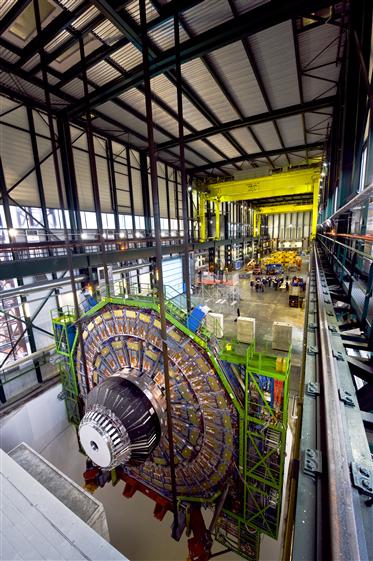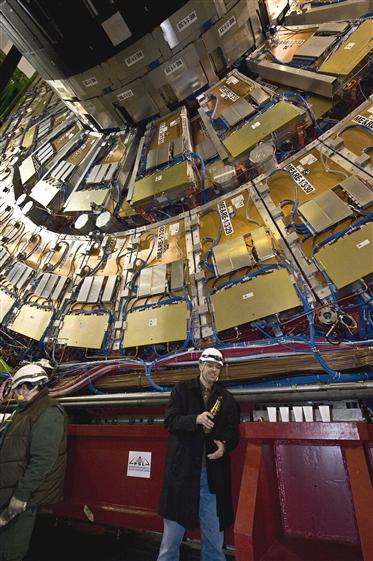Last tango in mid-air for CMS
TheYE-1 end-cap is the last CMS component to wave goodbye to the green grass of Cessy and plunge into the depths of the CMS cavern, bringing to an end a procession of spectacular descents lasting 15 months. See the video at the end of the article!
On Tuesday 22 January, the dance of the CMS end-caps came to an end with the lowering of YE-1, the heaviest of them all. After a spectacular lowering operation lasting ten hours, this mammoth component completed the 100-metre descent and was gently placed on the floor of the CMS cavern to the applause of the many onlookers. Weighing in at 1430 tonnes, the YE-1 end-cap positively dwarfs the YE-3 and YE-2 endcap disks, weighing 430 and 880 tonnes respectively (see Bulletin No. 49-50).
The YE-1 end-cap, the last section of the CMS detector to be lowered into the underground cavern, leaves behind an empty assembly hall.
This "Last Tango in Cessy" was an event charged with emotion for the onlooking CERN and CMS management teams, the posse of journalists in attendance, and especially the members of the CMS experiment groups and the technicians from VSL, the firm responsible for the successive handling manoeuvres.
CMS engineer Hubert Gerwig, who was in charge of the project, cracks open the champagne at the completion to mark the 15th and final spectacular lowering of the various detector sections.
"I just can’t get over seeing this mighty surface hall looking so empty. It makes you feel a bit empty inside," admits project engineer Hubert Gerwig with more than a hint of nostalgia. "After all, this has been the assembly hall for the CMS experiment for the past 10 years."
A total of fifteen components have safely taken this same, singular route, which has become the trademark of the CMS experiment. The undisputed daddy of them all was the YBO central barrel, weighing a hefty 2000 tonnes, which took the 100-metre plunge back in February 2007.
The last end-cap was safely delivered and temporarily stowed away as far as possible from the central components to leave room for the cabling for the tracker inside the vacuum tank and to allow the vacuum pipe in which the particles will circulate to be installed.
Once these components are all in place CMS will be practically ready. All that will remain will be to hermetically seal all the components of the detector, which will have to withstand the intense magnetic field of 4 tesla developed by the CMS coil.
The surface hall is now being used as an equipment store and will later be converted into a workshop, notably for running repairs. As far as the lifting equipment is concerned, the gantry crane will be dismantled and sold for scrap, while the four hydraulic jacks and the control tower will be shipped off to Durban, South Africa, where a new challenge awaits - lifting the roof of a stadium for the Football World Cup in 2010.




